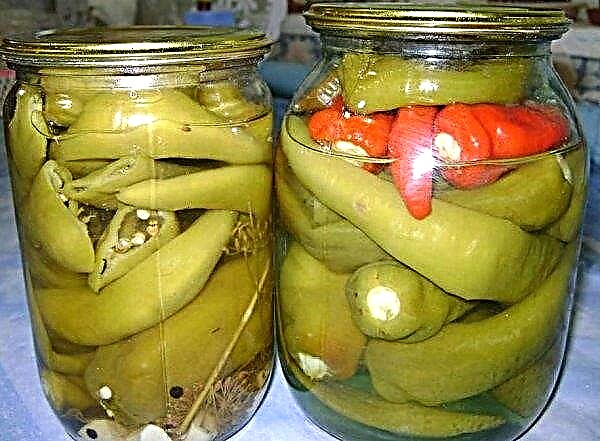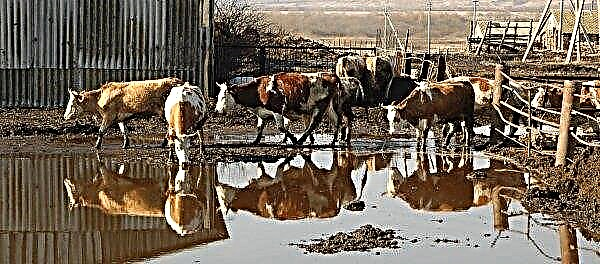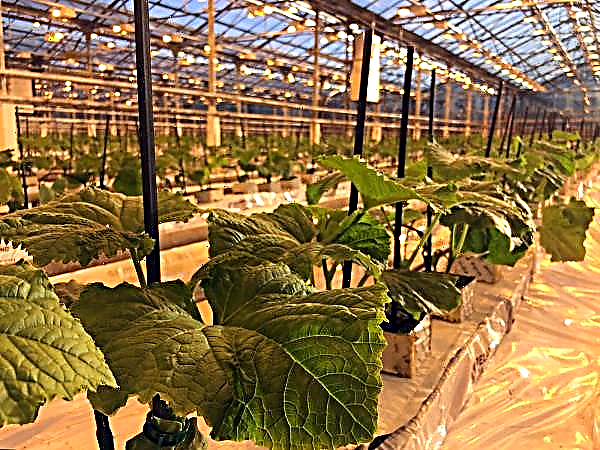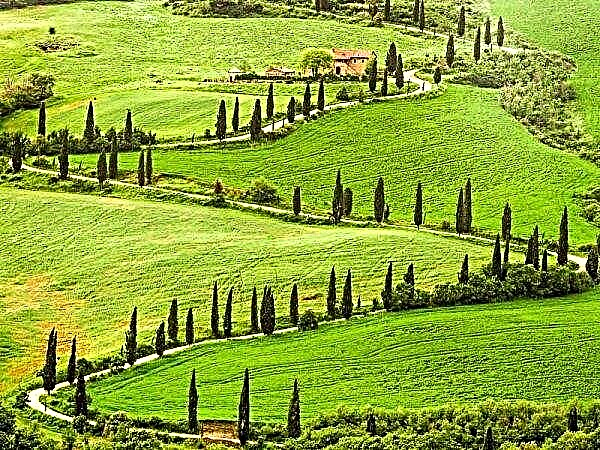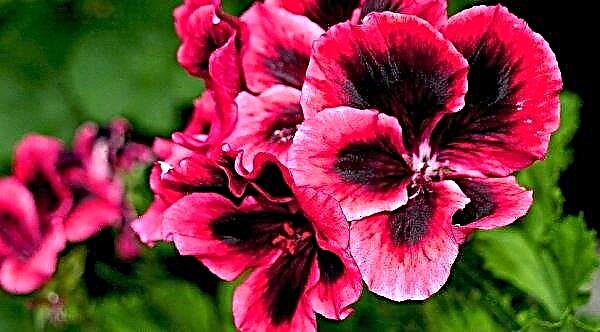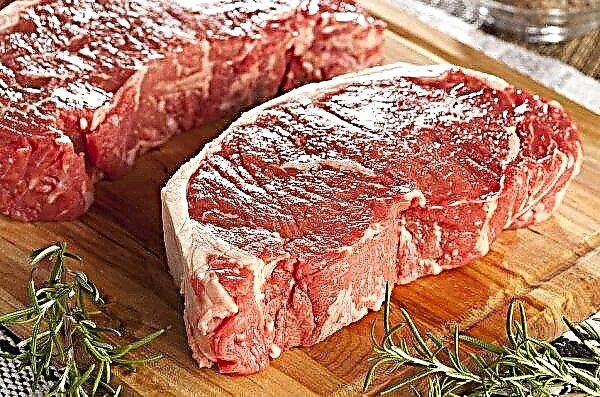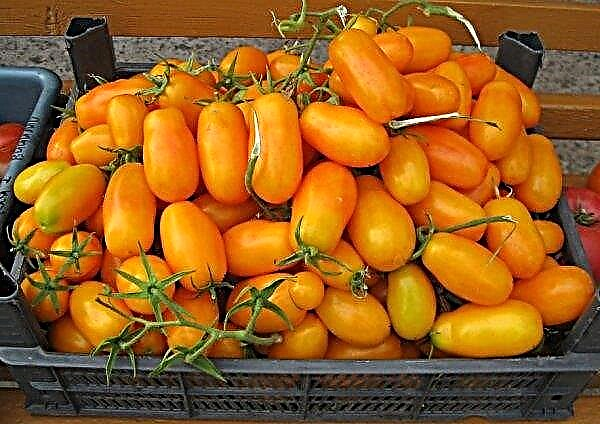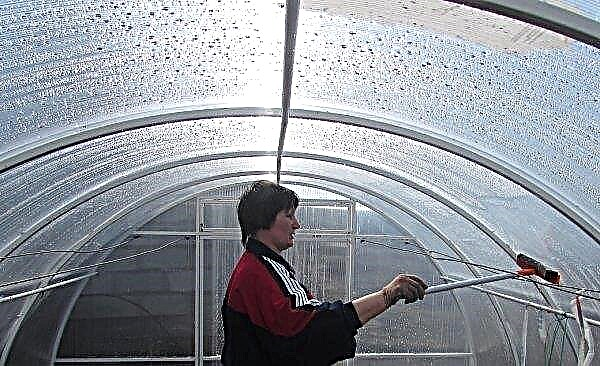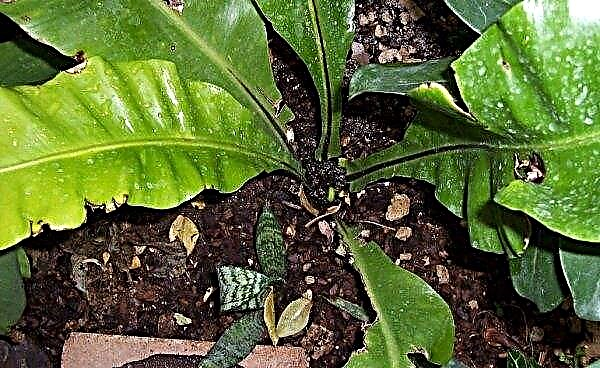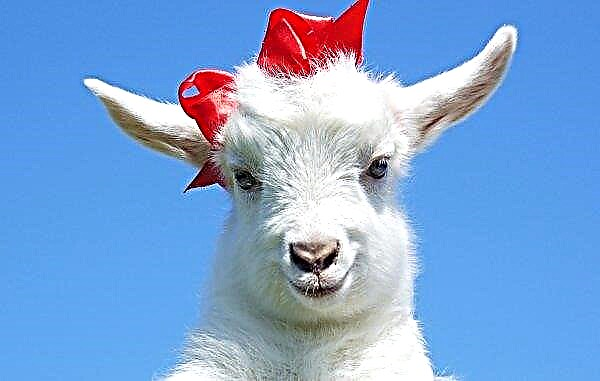Coniferous plants are popular among breeders and landscape designers. They attract attention with a variety of forms, year-round decorativeness, ease of planting and care. One of the common conifers is thuja. Description and features of cultivation of Fastigiata variety are contained in the article.
Botanical Description
The tree of the Fastigiata variety (lat.Thuja occidentalis Fastigiata) reaches a height of 15 m, a width of 3 m. The crown is formed in the form of a narrow cone or column. It is dense, thick. The needles are soft, scaly, painted green. Cones are formed small, 1–1.5 cm long. Their color is brown. The plant in appearance is very similar to cypress.
It is distinguished by the following characteristics:
- moisture lovingness;
- good frost resistance;
- undemanding to the composition of the soil;
- high level of decorativeness;
- long lifespan.
Did you know? Thuja in ancient Greek means “incense”. Ephedra was so named because the ancient Greeks and Romans burned its wood during rites in order to propitiate the gods.
Landing
Planting a thuja will not be difficult even for a person who does it for the first time. The planting process is quite simple. The main thing is to follow some rules:
- Choose a well-lit area, covered from drafts, with light, well-moistened, fertile, drained soils having an acid level in the range of 4.5–6 pH. Penumbra landing is allowed.
- Check that groundwater does not come closer than 1.5 m to the surface of the soil. Otherwise, arrange good drainage or plant a tree on a hill.
- Buy a seedling in a container, as it quickly adapts to open ground conditions.
- When planting, position the root neck at the same level with the surface of the earth.
- Prepare a landing pit 1-2 weeks before planting, making it 60–80 cm in size.
- At the bottom lay drainage from gravel 10–20 cm high.
- The earth extracted during digging, connected with peat and sand in a ratio of 2: 1: 1, as well as mineral fertilizers, best nitroammofoskoy (500 g).
- Transplant the seedling from the container by the method of transshipment - without breaking the earthen lump.
- After the root system of planting material is installed in the pit and sprinkled with earth, water using 10 liters of water.
- Finish the planting by laying in the near-trunk zone mulch from bark or peat.
 The thuja does not put forward special requirements, except for humidity and good illumination. When planting in dry soil and in the shade, the crown of the tree becomes more rare and less decorative.
The thuja does not put forward special requirements, except for humidity and good illumination. When planting in dry soil and in the shade, the crown of the tree becomes more rare and less decorative.
Thuja care
The described culture requires at least minimal care. It should consist of watering, fertilizing, cultivating, weeding, mulching. To make the tree grow beautiful and healthy, it should be pruned annually. You can avoid problems with a deterioration in decorativeness if regular inspections and preventive measures are taken to prevent diseases and harmful insects.
Nuances of seedling care
Most attention is required by young plants under the age of five or six. Since their root system is still underdeveloped, they need to be watered often - at least once a week. A bucket of water should be consumed per plant. If the weather is dry for a long time, then the number of irrigation should be increased up to two times a week, and the volume - up to two buckets. It is also important to irrigate - to water the crown of the plant with a diffused stream of water.
 So that the seedlings do not hurt the frost and do not burn the first sun's rays, in February they should be wrapped in burlap or other material that does not allow the sun to pass.
So that the seedlings do not hurt the frost and do not burn the first sun's rays, in February they should be wrapped in burlap or other material that does not allow the sun to pass.
Watering and feeding
The love of thuja loves to be watered more often. Adult plants can be moistened 2 times a month. The frequency and volume of irrigation will depend on weather conditions. Do not allow the earth to dry out very much.
Important! The last time fertilizers can be applied no later than the beginning of October. Later feeding can provoke a decrease in tree immunity and the development of various diseases.
In order for the tree to grow and develop well, to resist pathogenic bacteria and harmful insects, it should be fed 2 times a year, in spring and autumn, to feed. Fertilizers can be used universal, suitable for any plants. The most popular of these is Kemira Universal (100–120 g / m²). You can also use ready-made mixtures specifically designed for conifers, for example, Agrecol.
If fertilizers were introduced into the planting pit, then the first top dressing should be done no earlier than 2 years after planting. Until this moment, the young plant will spend those nutrients with which the earth was nourished.

Loosening and mulching
After each moistening, rainfall and weeding, the soil near the trunk of the plant needs to be loosened. This will improve its moisture and air permeability. As a result, water and oxygen in the right volume will pass to the root system. Since the root system of the thuja is located close to the soil surface, loosening should be shallow - 8-10 cm.
The soil in the near-stem zone should be mulched. Having covered the plot with mulch, it will be possible to water it less, loosen it, weed less often. Mulching allows you to maintain the optimum level of moisture in the soil, to restrain the growth of weeds, to improve the structure of the soil.
As mulch, you can use mowed grass, sawdust, straw. So that in winter these materials do not attract rodents to the tree, they must be replaced with spruce branches. Peat and wood chips are also suitable as mulch. The recommended height of the mulch layer is 7–10 cm. In winter, it needs to be increased to 15–20 cm.

Pruning
Thuja tolerates pruning well, quickly restored after it. The formation of the crown is optional, but only if necessary. When growing in hedges, pruning trees should be moderate, not more than a third.
In the spring it is required to cut plants for sanitary purposes. At this time, you need to remove all the old, yellowed, broken, sick, incorrectly growing, twisted branches. Pruning should be done with a sanitized tool. It must be treated with a disinfectant after each plant. You can’t use devices on several trees or shrubs, because this way you can spread the disease. The places of cuts must be treated with copper sulfate and glossed over with garden var or RanNet.

Breeding
Thuja can be propagated in two ways:
- seed;
- vegetative.
At home, this crop is not bred by seeds because of the complexity of the process. This method is used mainly in nurseries by people with the appropriate education and skills.

At home, you can cuttings. Cuttings need to be harvested from adult trees in late autumn. They should be carefully separated from the mother plant and put in a bag with a clasp filled with a mixture of 1 kg of leafy soil and 1 kg of sand. While the stem is rooted, it needs to be aired and moistened daily as the topsoil dries. It is better to grow it in a dark place.
Rooting should occur a month later. After this, the stalk is transplanted into a pot and placed in a place well lit by sunlight. It needs to be humidified every 2 days. As soon as the plant grows, it can be transplanted into the open ground.

Possible diseases and pests
Thuja is rarely sick or affected by pests. Changes in appearance, a decrease in decorativeness, oppression of the tree, yellowing and dropping of needles indicate that mistakes were made during planting or insufficient care is being provided.
Regular preventive measures will help prevent infection with diseases and pests, including:
- fertilizer application;
- thorough cleaning of the site in the fall;
- deep digging of the soil in the autumn period;
- sanitary scraps;
- preventive spraying with fungicides "Fundazol", "HOM", "Abiga-Peak", "Topsin-M", Bordeaux liquid, copper sulfate.

If the plant still struck the disease, then you can find out about its symptoms and treatment methods from the table:
| Disease name | Symptoms of infection | Treatment methods |
| Fusarium |
| Water and spray the plants with the “Fundazole” solution (0.2%). |
| Branch drying | drying of shoots is observed | Timely fight pests. |
| Pestalocium wilting |
|
|
| Schütte | turns yellow in spring and becomes covered with a gray coating of needles | In spring and autumn, spray with Bordeaux liquid (1%), copper, iron sulfate. |
| Stem rot |
|
|

Insect damage is also possible to avoid. The table selects the most dangerous pests and methods of combating them:
| Insect name | Symptoms of lesion | Methods of prevention and treatment |
| Thuja aphid | the needles turn yellow and fall |
|
| Speckled Moth |
| Since the end of June, 2 times at weekly intervals, treat the tree with pyrethroid-based products. |
| False shield | yellow ulcers appeared on the cortex |
|
| Wireworm |
|
|
| Spider mite |
|
|

The use of wood in landscape design
Tuyu Fastigiata is most often used in group landings. The most common composition with its use is a hedge. "Green walls" can be high or low, trimmed.
Did you know? Native Americans used thuja wood to build canoes.
Often also used to create large panoramic compositions. A large number of plants are planted in them, having different architecture and contrasting color of leaves. Fastigiata is also planted as a tapeworm.

So, one of the most popular varieties of thuja western among summer residents is Fastigiata. It attracts with the fact that it is possible to make beautiful living fences from it, allowing you to hide the yard from prying eyes. If a tree is correctly planted, regularly watered and fed, then it will delight with its beauty for many years and not one generation. After all, this culture is able to live up to 200 years.

